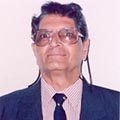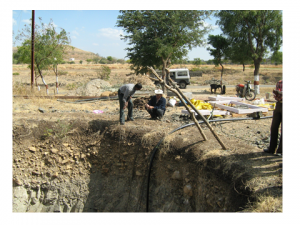While collecting hydrogeological data, talk to the local people – the farmers, etc. Show interest in their problems. The local people often give valuable information from their experience.”
August 2018: Shrikant Limaye kindly offered to contribute his thoughts. A long standing IAH member and groundwater consultant, Shikrant is also Past President of AGID (Association of Geoscientists for International Development) and co-founder of IAPG (International Association for Promoting Geoethics), an IAH partner that is a multidisciplinary, scientific platform for widening the discussion and creating awareness about problems of Ethics applied to the Geosciences. With such a background and wealth of experience, he has many interesting and useful comments for us…
 Tell us a little about yourself….
Tell us a little about yourself….
I am a hydrogeologist by birth. My father Mr D.G. Limaye graduated in Agricultural Science in 1931 and started working as a groundwater consultant for farmers in 1933. From 1950, when I was 12 years old, I used to accompany him on fieldwork during school vacations. My early training involved travelling by bicycle on village roads, talking to farmers, visiting dug-wells to see the rock types, making field notes, and eating very spicy (hot) food at farmers’ homes…
I graduated with First Class Honours in electrical Engineering in 1959 from the University of Poona and was offered a scholarship to study Power Engineering at Purdue University in America. But I really wanted to join my father’s profession, so I went on to the Indian Institute of Technology, Kharagpur (IIT – KGP) and graduated with an MTech degree in Exploration Geophysics a few years later.
From 1962 to 1969, I worked with my father. In this period we developed an advanced model of an A.C. Electrical Resistivity Meter, which was quite an improvement over our old D. C. Resistivity Meter. Indeed, we were the first team in India to use a resistivity meter for groundwater exploration in the private (non-government; non-university) sector. Our clients were the industries facing water shortages – farmers could not afford the cost for resistivity exploration by our small team of two experts, four assistants and eight to ten labourers.
In 1969, I got scholarship to study groundwater exploration in a six-month course at Ground Water Centre (GWC) of the Hebrew University in Jerusalem. In those days, Israel used to suffer from many terrorist attacks on civilians. But my wife Pushpa fully supported my going to Israel, even though our three children were very young. In Jerusalem, I had first-hand experience with bomb-explosions twice: at the Supersol Market in central Jerusalem and at the cafeteria in Hebrew University. I missed both these explosions merely by a matter of a few minutes.
This course at the GWC was sponsored by UNESCO and the Government of Israel. It was a big step in my career. Prof. Samuel Mandel was the chief instructor for the course – he was a very practical teacher and had worked on groundwater development projects in many countries. He gave case studies from his projects in Iran, Korea, Mexico, Columbia etc. GWC also invited outside experts like Prof. Arie Issar of ‘Ben Gurion University of the Negev’ to teach at this course. I consider myself very fortunate that I was a student of Prof. Samuel Mandel and Prof. Arie Issar.
AGID & ME: The 24th International Geological Congress (IGC) was held in Montreal in 1972. In this IGC, a group of Canadian Geologists including Prof. Roger Blais (who later on was honoured with the title “Order of Canada”), Dr Antony Berger and other liked minded geoscientists from various countries decided to found AGID (Association of Geoscientists for International Development) with financial support from CIDA (Canadian International Development Agency). AGID held its first election of the Council the during the 25th IGC in Sydney, and I was elected as a councillor. This position gave me the opportunity to visit several countries including Venezuela, USA, Russia, France and Thailand, in order to attend Council Meetings.
Later on in 1996, I was elected as AGID President and worked for 8 years till 2004, when Ms Afia Akhtar, Director General of the Geological Survey of Bangladesh was elected as President. I am still associated with AGID as Past President and Ex-Co member. Like IAH, AGID is affiliated to IUGS. For the past 32 years I have been publishing “AGID Newsletter” from my office in Pune, India.
Why did you join IAH?
Prof. Arie Issar from Israel, mentioned above, told me about IAH and persuaded me to join as a member. At the beginning of the new millennium I had completed 25 years of membership and received an anniversary certificate from Dr Andrew Skinner, IAH Secretary General. In those days paying membership dues in hard currency was sometimes a problem for a private groundwater consultant like me but somehow my IAH membership survived.
What would you say have been your career highlights, successes, etc.?
I had an opportunity to work as a groundwater consultant in Nigeria (on a World Bank project); in Laos (on a project by FAO-Rome) and in Bangladesh (on Asian Development Bank’s “1st Agricultural Project).
My UNECO-IUGS-IGCP Project “Ground Water Network for Best Practices in Ground Water Management in Low-Income Countries” has been perhaps the most successful Project under IUGS-IGCP umbrella. Its website www.igcp-grownet.org has received around 35,000 visits to date.
In IAH Congress in Beijing in 2006, IAH honoured me with a citation and with “Honorary Life Membership” of the Association.
From 2010 onwards, I started promoting Geoethics for eco-friendly and socio-friendly use of Geo-Resources. In 2012, at the 34th IGC in Brisbane, myself and my friend Dr Silvia Peppoloni (from Institute for Geology and Volcanology – Rome) founded the IAPG (International Association for Promoting Geoethics – Website www.geoethics.org ). Nowadays, IAPG has members in 124 countries and a network of 30 national sections. I am Vice President of IAPG and Dr Silvia is the Secretary General. In 2016, Dr Silvia also got elected to the IUGS Council.
In 1970s, in an Agricultural Development Project in Chhattisgarh area in India, my father and I surveyed 1,500 farms of small farmers (below 1.5 Ha land-holding) in three years period and advised on dug wells in order to obtain groundwater for small-scale irrigation. These farmers were traditionally taking only one crop of paddy in a rainy season. After digging wells, they started growing wheat in winter and vegetables and flowers on tiny plots in summer season. The improvement in the income and in the living conditions of these poor farmers was an incredible sight for us.

Taking water level measurements is a regular work for any Hydrogeologist. (Here I am sitting by the side of a dug well, in drought-prone area.)
In my capacity as groundwater consultant for cement factories in the coastal area of Gujarat state in India, I advised that the lowest bench of open-cast limestone mining pits of the factories should be used in the rainy season for collecting rain water and augmenting recharge to groundwater body. Such practice of using the high level mining pits for recharge to groundwater pushed back the sea water/fresh water interface and many dug wells of coastal farmers started providing better quality of water for irrigation. It also created very cordial relations between the cement factories and the farmers in surrounding villages.
Any career “low points” or experiences you have learned from, that you are willing to share with others? Particular challenges?
In fractured hard rock aquifers, even after conducting proper exploration for selecting suitable sites for digging open wells or drilling bore wells, there is unfortunately 10% failure in bore wells and 5% failure in dug wells. A failed dug well becomes dry in summer but at least gives some water for irrigation in other seasons. A failed bore well is a total failure. Also that hydro-fracturing is not possible in low-income countries.
What piece(s) of equipment/software/item have you found the most useful/you could not have managed without throughout your career?
A geological hammer, a 30m tape to measure depth to water table, a GPS monitor, a drinking water bottle, good quality field shoes, a sunhat, goggles, a packet of biscuits and a notebook are essential for field work by an individual hydrogeologist.
What are your concerns now or for the future, relating to groundwater/hydrogeology?
Watershed protection with soil and water conservation methods and forestation should be taken up with active participation of local people. Watershed is the interface or meeting point climatology and hydrology/hydrogeology. Sustainable surface water and ground water could be obtained only if the watershed is well maintained and forested.
What three tips might you give to someone just starting out on their study or career?
Always remember that:
- Groundwater is a hidden source flowing through a complex matrix of fractures in hard rocks or through intercalated layers of sand and clay. Whatever we do in mathematical hydrogeology and modelling is often under assuming highly simplified conditions which may not necessarily be true out in the field.
- Always give prime importance to field work and well-inventory.
- While collecting hydrogeological data, talk to the local people – the farmers, etc. Show interest in their problems. The local people often give valuable information from their experience.
Your future plans? Aspirations?
At 81 years of age, preparing long term future plans is not practical. In short term, I wish to promote Socio-Hydrogeology. Also, keeping good health is essential for doing field work. I have therefore been practising Yoga and Pranayama for many years.
What has being a member of IAH brought to you?
IAH has got me friends in many countries. The Papers in Hydrogeology Journal give a glimpse of the research being carried out by scientists working in the forefront of hydrogeology, expanding our horizon of knowledge about groundwater.
Is there anything IAH should be doing? Could do better?
IAH as an Association is already doing great in membership service. If possible, a Membership Directory may be published every five years with postal and email addresses of members in each country. [ed: we have an “opt in” online directory in our Members’ Area…].
Additional comments – matters you would like to raise?
Hydrogeology Journal is giving us more than 1600 pages per year for reading and thinking. But I do not see any discussions on the published papers – so I wonder how or if the members find time to read them?
In many developing countries including India, there is a tendency to recognise only the work done by Government Institutions/Departments and Universities. The technical work done by the private sector, although appreciated at international levels, remains neglected in India.
Shrikant Limaye



